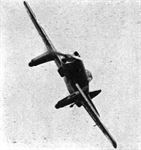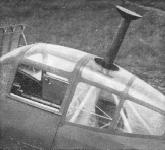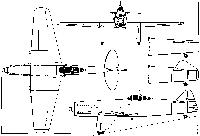
MB.2
Martin-Baker M.B.1 и M.B.2
В 1934 году Джеймс Мартин основал компанию "Martin-Baker Aircraft Company", задачей которой было налаживание производства самолетов, основой конструкции которых был необычный каркас, разработанный самим Джеймсом Мартином. Последний утверждал, что такой каркас позволит снизить массу летательного аппарата, обеспечив одновременно надлежащую прочность конструкции и, что немаловажно, приемлемую стоимость такого самолета и простоту его эксплуатации и ремонта. Первым самолетом такой конструкции стал M.B.1 - свободнонесущий низкоплан с закрытой кабиной для двух членов экипажа и двигателем Napier Javelin IIIA мощностью 160 л. с. Самолет впервые поднялся в воздух в марте 1935 года. Так и оставшийся в единственном экземпляре, этот опытный самолет сгорел в начале 1938 года. После этого компания "Martin-Baker" приступила к проектированию одноместного истребителя - под требования британского министерства авиации № R5/34. Построенный в итоге прототип M.B.2 представлял собой "чистый" свободнонесущий низкоплан, оснащенный двигателем Napier Dagger III "H" мощностью 1000 л. с. Первый его полет состоялся 3 августа 1938 года. В самолете нашли воплощение многие новейшие на то время идеи, а в ходе официальных испытаний машина показала весьма высокую максимальную скорость - 563 км/ч. Однако заказа на серийное производство не последовало, самолет вскоре был разобран.
Описание:
- MB.2
- Flight, June 1939
A NEW MULTI-GUN FIGHTER - Flight, November 1939
Britain's Military Aircraft
Фотографии
-
Авиация и Космонавтика 2012-08 / В.Котельников - Истребители фирмы "Мартин-Бейкер" /Самолеты Второй Мировой войны/
MB.2 в демонстрационном полете
The Martin Baker multi-gun fighter is of unusual appearance. It is fitted with a Napier Dagger twenty-four cylinder aircooled engine and is of very simple, but sturdy, construction. -
Flight 1939-06 / Flight
Perhaps the most remarkable feature of Capt. Baker’s demonstration was the tightness of his turns near the ground.
-
Aeroplane Monthly 1985-07 / A.Lumsden, T.Heffernan - Probe Probare (14)
The picture, taken in May 1939, shows the M.B.2 flying at Heston with the definitive fin and rudder.
-
Авиация и Космонавтика 2012-08 / В.Котельников - Истребители фирмы "Мартин-Бейкер" /Самолеты Второй Мировой войны/
MB.2 в первоначальном варианте без вертикального оперения
-
Air Enthusiast 1995-09 / P.London - Martin-Baker's Aeroplanes
The works team that built the MB 2 fighter prototype probably immediately following completion in July 1938. At that early stage the MB 2 had no fixed fin or rudder area projecting above the line of the rear fuselage.
-
Air Enthusiast 1995-09 / P.London - Martin-Baker's Aeroplanes
Left pilot partner Valentine Baker, centre, James Martin and right, Francis Francis who added much-needed financial muscle to the fledgling enterprise. In the background, the MB.2.
-
Aviation Historian 20 / P.Jarrett - The Blue Falcon
The three founding members of Martin-Baker Aircraft beside the M.B.2 in 1939. From left: Capt Valentine Henry Baker, who was killed in the M.B.2’s successor, the M.B.3, in September 1942; James Martin, who was so affected by Baker’s death that he established Martin-Baker as the world leader in ejection-seat technology, and Francis Francis.
-
Flight 1939-06 / Flight
The men behind it (left to right): Capt. V. H. Baker, Mr. J. Martin and Mr. Francis Francis (Martin-Baker Aircraft); Sir Harold Snagge (chairman of Napiers), Maj. F. B. Halford (designer of the engine), Mr. A. E. Hagg and Mr. W. P. Savage, of Napiers.
-
Aeroplane Monthly 1985-07 / A.Lumsden, T.Heffernan - Probe Probare (14)
The M.B.2 photographed at Martlesham Heath in November 1938 after the tiny fin was added.
-
Мировая Авиация 184
Ошибочно на фюзеляж прототипа M.B.2 нанесли надпись "M.B.1". Виден небольшой киль, который позже увеличили.
-
Air Enthusiast 1972-12 / Plane facts
Built as a private venture to meet the Air Ministry F.5/34 specification, the M.B.2 was first flown with the markings M-B-1.
-
Air Pictorial 1958-05 / Scrapbook
MISLEADING LEGEND. A hitherto unpublished photograph of the Martin-Baker M.B.2 - unearthed by Chris Cole of the Air Ministry's Press Division - reveals the faintly discernible fuselage inscription "M-B-I". This view shows the second form of tail assembly (the first possessed no fin area above the tailplane). which was later revised to a taller, conventional-style fin and rudder shape. The sole prototype (P9594) was designed to Air Min. Spec. F.5/34 as an eight-gun fighter (0.303.-in. Brownings), powered by a 1,000-h.p. Napier Dagger Srs. III.
-
Авиация и Космонавтика 2012-08 / В.Котельников - Истребители фирмы "Мартин-Бейкер" /Самолеты Второй Мировой войны/
MB.2 вскоре после сборки с промежуточным вариантом киля
-
Air Enthusiast 1995-09 / P.London - Martin-Baker's Aeroplanes
MB 2 at the intermediate stage at which the sole prototype embodied a small vertical fin.
-
Aeroplane Monthly 1985-07 / A.Lumsden, T.Heffernan - Probe Probare (14)
Регистрационный номер: P9594 [8] The M.B.2 photographed at Martlesham in June 1939, where further testing showed that modifications to the rudder had made it considerably more effective. By this time the serial number P9594 had been applied.
-
Aeroplane Monthly 1989-05 / F.Hislop - Memories (1)
Регистрационный номер: P9594 [8] MB.2 с окончательным вариантом оперения. Выдвинут противокапотажный пилон
The sole Martin Baker M.B.2 private venture single-seat fighter was powered by a 798 h.p. 24-cylinder Napier-Halford Dagger M.3 engine. Later it acquired the RAF serial number P9594. It is seen here at Heston in May 1939.
The Martin-Baker fighter is an example of a well-faired "trousered" type of landing gear. -
Aeroplane Monthly 1985-07 / A.Lumsden, T.Heffernan - Probe Probare (14)
Регистрационный номер: P9594 [8] Taken at Heston in May 1939, this photograph shows the sleek lines of the M.B.2 to advantage. The aircraft was painted deep olive all over and bore roundels outlined in yellow.
-
Aviation Historian 20 / P.Jarrett - The Blue Falcon
Регистрационный номер: P9594 [8] Простота конструкции делала M.B.2, что называется, мечтой для авиатехников, но вот пилоты от него в восторге не были.
The first aircraft developed by the newly-formed Martin-Baker Aircraft Co Ltd was the M.B.1 two-seat light tourer, but by March 1936 the company had started building a modern single-seat fighter, the Napier Dagger-powered M.B.2, seen here in 1939, after it had been given the RAF serial P9594. First flown by Valentine Baker on August 3, 1938, the fixed-undercarriage M.B.2 could not compete against the Hurricane and Spitfire, both already in RAF service by that time. -
Aeroplane Monthly 1985-07 / A.Lumsden, T.Heffernan - Probe Probare (14)
Регистрационный номер: P9594 [8] -
Aeroplane Monthly 1979-12 / Heston /Gone but not forgotten/ (6)
Регистрационный номер: P9594 [8] The square-cut appearance of the new Martin-Baker multigun fighter is accentuated by the lines of the nose cowl over the Napier Dagger engine. There is an electrically operated ”crash post” which is normally housed within the cockpit enclosure.
The Martin-Baker M.B.2 private venture, single-seat fighter powered by a 1,000 h.p. Napier Dagger III engine, originally allocated the registration G-AEZD, seen at Heston in June 1939. -
Air Enthusiast 1995-09 / P.London - Martin-Baker's Aeroplanes
Регистрационный номер: P9594 [8] Purposeful gait of the MB 2 in evidence. Note extended crash-post protruding from the cockpit.
-
Aeroplane Monthly 1985-07 / A.Lumsden, T.Heffernan - Probe Probare (14)
Регистрационный номер: P9594 [8] Further view of the M.B.2 taken at Heston in May 1939. In the photograph the crash pylon is extended to give protection to the pilot in the event of the aircraft overturning.
-
Air Enthusiast 1972-12 / Plane facts
The turn-over pylon extended.
-
Aeroplane Monthly 1985-07 / A.Lumsden, T.Heffernan - Probe Probare (14)
Two photographs showing the gun ammunition box and the installation of the eight Browning 0-303in machine guns. Later, the Martin Baker company was instructed to install two 20mm cannon in each of the M.B.2’s wings and carry out 10hr of flight testing and firing.
-
Air Enthusiast 1972-12 / Plane facts
The general arrangement drawing shows the Martin Baker M.B.2 in its final form with scrap views of the original and intermediate vertical control surfaces.
-
Air International 1985-11 / Fighter A to Z
The Martin-Baker M.B.2 in its definitive form with orthodox tail surfaces.
-
Air Enthusiast 1995-09 / P.London - Martin-Baker's Aeroplanes
Martin-Baker MB.2
-
Авиация и Космонавтика 2012-08 / В.Котельников - Истребители фирмы "Мартин-Бейкер" /Самолеты Второй Мировой войны/
Схема окончательного вида MB.2
- Фотографии



























